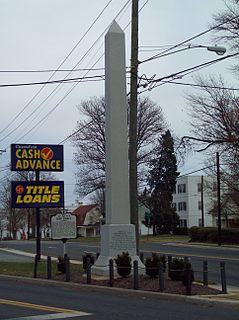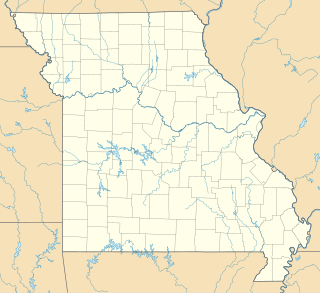
The Atchison, Topeka and Santa Fe Passenger and Freight Complex is a nationally recognized historic district located in Fort Madison, Iowa, United States. It was listed on the National Register of Historic Places in 1992. At the time of its nomination it contained three resources, all of which are contributing buildings. The buildings were constructed over a 24-year time period, and reflect the styles that were popular when they were built. The facility currently houses a local history museum, and renovations are underway to convert a portion of it back to a passenger train depot.

The Virginian Railway Passenger Station, also known as the Virginian Station is a former rail station listed on the National Register of Historic Places in the South Jefferson neighborhood of the independent city of Roanoke, Virginia, U.S.A. Located at the intersection of Jefferson Street SE and Williamson Road, the Virginian Station served as a passenger station for the Virginian Railway between 1910 and 1956. The station was the only station constructed with brick along the entire length of the Virginian's 608 miles (978 km) network. It was severely damaged by fire on January 29, 2001.

The Fort Early and Jubal Early Monument was started in the early 1900s, and consists of the remains of an American Civil War fort and monument located on a 1.29-acre (5,200 m2) site at Lynchburg, Virginia. Confederate forces under the command of Lt. Gen. Jubal Early constructed the roughly square earthen fort in June 1864 as part of the outer defenses of Lynchburg as the Union Army of West Virginia, under Maj. Gen. David Hunter, advanced from the north and west in an attempt to capture the city during the Battle of Lynchburg. It is the only section of the Lynchburg defenses still in existence.

Mitchell's Brick House Tavern, also known as Oakland, Hite House, Goodwin Tavern, Goodwin House and Coco House, is a historic home located at Arrington, Nelson County, Virginia. It is a two-story, painted brick Greek Revival-style house with a raised or English basement, built about 1838. The estate consists of the main house with two additions, several dependencies, a garage, and the small Goodwin Family cemetery.

The Herndon Depot Museum, also known as the Herndon Historical Society Museum, is located in the town of Herndon in Fairfax County, Virginia. Built in 1857 for the Alexandria, Loudoun & Hampshire Railroad, the depot later served the Richmond and Danville Railroad, the Southern Railway and the Washington and Old Dominion Railroad. The structure is located at 717 Lynn Street, at the intersection of the Washington & Old Dominion Railroad Trail and Station Street, north of Elden Street. The building is adjacent to Town Hall Square, which contains the Herndon Town Hall, built in 1939 as a Works Progress Administration project to house all of the Town's administrative offices.

The Bloomington freight station is a historic train station in downtown Bloomington, Indiana, United States. Constructed in the early twentieth century, it has endured closure and a series of modifications to survive to the present day, and it has been declared a historic site. Used only occasionally for many years, it is one of the most important buildings in a large historic district on the city's west side.

Mitchells Presbyterian Church is a historic Presbyterian church located on VA 652 in Mitchells, Culpeper County, Virginia. It was built in 1879, and is a one-story, frame building in the Carpenter Gothic style. It measures 50 feet by 30 feet and sits on a brick foundation. The interior features a trompe-l'œil fresco added between 1892 and 1899 by well-known local artist Joseph Oddenino. He also painted the interior murals at Elmwood.

Edgemont, also known as Cocke Farm, is a historic home located near Covesville, Albemarle County, Virginia. It was built about 1796, and is a one- to two-story, three bay, frame structure in the Jeffersonian style. It measures 50 feet by 50 feet, and sits on a stuccoed stone exposed basement. The house is topped by a hipped roof surmounted by four slender chimneys. The entrances feature pedimented Tuscan order portico that consists of Tuscan columns supporting a full entablature. Also on the property is a rubble stone garden outbuilding with a hipped roof. The house was restored in 1948 by Charlottesville architect Milton Grigg (1905–1982). Its design closely resembles Folly near Staunton, Virginia.

Limestone, also known as Limestone Plantation and Limestone Farm, has two historic homes and a farm complex located near Keswick, Albemarle County, Virginia. The main dwelling at Limestone Farm consists of a long, narrow two-story central section flanked by two wings. the main section was built about 1840, and the wings appear to be two small late-18th-century dwellings that were incorporated into the larger building. It features a two-story porch. The house underwent another major renovation in the 1920s, when Colonial Revival-style detailing was added. The second dwelling is the Robert Sharp House, also known as the Monroe Law Office. It was built in 1794, and is a 2 1/2-story, brick and frame structure measuring 18 feet by 24 feet. Also on the property are a contributing shed (garage), corncrib, cemetery, a portion of a historic roadway, and a lime kiln known as "Jefferson's Limestone Kiln" (1760s). Limestone's owner in the late-18th century, Robert Sharp, was a neighbor and acquaintance of Thomas Jefferson. The property was purchased by James Monroe in 1816, after the death of Robert Sharp in 1808, and he put his brother Andrew Monroe in charge of its administration. The property was sold at auction in 1828.

Fort Colvin, also known as Covill's Fort and Colvin House, is a historic home located near Winchester, Frederick County, Virginia. It was built about 1750, and is a 1 1/2-story, stone and frame building with a metal gable roof and interior chimney. It measures 24 feet by 34 feet and is nearly centrally positioned over a spring. Also on the property are a contributing site of a small domestic outbuilding and the ruins of a small footbridge. Fort Colvin is believed to have been built by some of the first European settlers in the first multi-ethnic community west of the Blue Ridge Mountains in Virginia. It is thought to have been used as a settler's fort by Joseph Colvill in 1755.

Norge Train Depot is a historic home located at Norge, near Williamsburg, James City County, Virginia. It was built about 1907 by the Chesapeake and Ohio Railway from standardized plans. The train station is the last surviving example of a wood frame "informal standard" depot in the six states that were served by Chesapeake and Ohio Railway. Originals were built according to an informal plan and no standard drawings were prepared or entered in the railway's set of design standards.

Eubank Hall, also known as Haleysburg and Eubank Plantation, is a historic home located near Fort Mitchell, Lunenburg County, Virginia. It is an "L"-shaped dwelling, consisting of a 1 1/2-story frame, square, single-pen house built about 1790, with a later two-story frame addition, and a three-story, frame, single-pile addition added about 1846. It has a hipped roof and features two Jacobean-style chimneys. Also on the property is the contributing foundation of a kitchen.

Cambria Freight Station, also known as Christiansburg Depot, is a historic freight station located at Christiansburg, Montgomery County, Virginia. It was built in 1868-1869, and is a wood-framed, one-story, U-shaped structure with a shallow hipped roof and deeply overhanging eaves in the Italianate style. A portion of the center section rises to form a tower-like second-story room, covered with an even shallower hipped roof. A long, one-story freight section extending eastward from the rear. The building also served as a passenger station, until a new passenger station was built nearby on 1906. The building houses a local history museum known as the Cambria Depot Museum.

Norfolk & Western Railway Depot is a historic railway depot located at Marion, Smyth County, Virginia. It was built in 1904 by the Norfolk and Western Railway. It is a one-story, stone and brick, Queen Anne style building. It features detailed porches supported by arching brackets on the street side and iron columns on the other three sides and a slate and shingled hipped roof with dormers. The building measures 25 feet by 128 feet, and has an attached former ticket office. The building was converted for office and retain use in 1993-1994.

Redoubt No. 2, also known as Fort No Name, is a historic archaeological site located near Stafford, Stafford County, Virginia. The site was the central of the three, perhaps four, Federal defensive fortifications ordered constructed in early (February) 1863 during the American Civil War to protect the approaches to the Union supply depot at Aquia Creek Landing, Stafford, Virginia. Redoubt No.2 is an earthen field fortification that is nearly 95 feet square.

Greensville County Training School, also known as the Greensville County Learning Center, is a historic Rosenwald school building located at Emporia, Virginia. It was built in 1929, and is a single story, "U"-shaped brick building. It consists of a front hyphen that connects two wings containing classrooms, while an auditorium, office space, and a library form the interior central space. A classroom addition was constructed in 1934. It was constructed for the education of African-American students, and closed in the 1960s following desegregation of the public schools.

Lee Hall Depot is a historic railway depot located in the Lee Hall neighborhood of Newport News, Virginia. It was built about 1881, as a one-story, frame building. A two-story midsection was added in 1893 with Stick Style embellishments and a pentagonal two-story bay. A one-story wing was added by the Chesapeake and Ohio Railway to the north end of the depot in 1918 to handle the influx of military personnel to Fort Eustis. The depot was used for passenger service until Amtrak took over service on May 1, 1971. Amtrak resumed service to Lee Hall with the Colonial on October 30, 1977. The Lee Hall Depot was moved from its original location in 2009 to prevent it from being demolished by the CSX Railroad. The building is under restoration to be used as a local history museum.

Hampton Depot is a historic train station in Hampton, Henry County, Georgia. It was listed on the National Register of Historic Places in 1979.

The Hermitage, also known as Devereaux House, is a historic home located at Virginia Beach, Virginia. The original section was built about 1700, with two later additions. It is a 1 1/2-story, four bay, Colonial era frame dwelling. The second portion was constructed by about 1820, doubling the size of the dwelling, and the final portion was added in 1940. Also on the property are three outbuildings, as well as a large subterranean brick cistern, now part of the basement to the house.

Olean Railroad Depot is a historic train station located at Olean, Miller County, Missouri. It was built about 1884, and is a one-story, rectangular frame building with board and batten siding. The building measures 16 feet, 2 inches, by 40 feet, 3 inches. It has a gable roof with a four foot wide overhang supported by brackets all around and the gable ends embellished by decorative truss work. The depot closed in 1962.



























